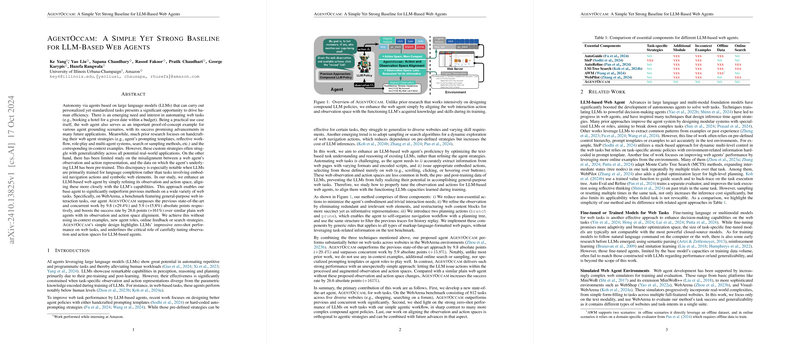Overview of AgentOccam: A Baseline for LLM-Based Web Agents
This paper introduces AgentOccam, a novel baseline methodology for deploying web agents grounded in LLMs. Recognizing the potential challenges LLMs face in executing web-based tasks, this paper emphasizes optimizing the alignment between an agent's observation-action space and the capabilities inherent in LLMs. Fundamentally, the paper proposes practical strategies aimed at refining this space to enhance task performance.
Key Contributions and Methodology
The cornerstone of AgentOccam lies in its streamlined design, deliberately eschewing the deployment of complex agentic strategies such as in-context examples, new roles, or online search methodologies. Instead, AgentOccam focuses on refining observation and action spaces suitable for LLM utilization:
- Action Space Simplification: The action space is critically analyzed to remove non-contributory actions and those demanding robust embodiment understanding. Actions like #1{hover} and #1{press} are simplified or consolidated. Additionally, new supportive actions like #1{note} and #1{stop} are integrated to enable better memory management and decision points.
- Observation Space Refinement: The observation space is optimized by restructuring web content, eliminating redundancy, and emphasizing crucial elements through actionable rules in the web data hierarchy, enhancing the perception capabilities of LLMs.
- Innovative Planning: Introduces planning actions like #1{branch} and #1{prune} that allow the agent to autonomously generate, navigate, and prune execution plans, effectively managing task decomposition and workflow in dynamic web environments.
Empirical Results
AgentOccam demonstrates superior performance on the WebArena benchmark, significantly elevating success rates from 37.2% to 43.1%, marking an improvement over previous state-of-the-art methods by up to 15.8%. This increment underscores the efficacy of aligning observation-action spaces to leverage the LLM’s pre-trained capabilities, emphasizing zero-shot performance.
Theoretical Implications
The insights from AgentOccam underscore the criticality of aligning machine representations and real-world task needs within LLM paradigms. By refining action and observation spaces, the paper highlights the adaptability and artificial reasoning potential of LLMs without necessitating extensive retraining or architectural overhauls.
Practical Implications
Practically, AgentOccam represents a pivotal step toward using LLMs in automating real-world web interactions, such as online shopping or database management, without requiring domain-specific adjustments. This aligns with the broader objective of harnessing LLMs for efficiency enhancements in repetitive and predictable web tasks.
Future Directions
Looking forward, integrating validated observation-action alignment strategies with potential agentic improvements — like role specialization or dynamic multi-agent interactions — could exponentially enhance both task execution quality and scope. Moreover, examining the scalability of such methodologies across increasingly complex and varied web environments offers avenues for future research.
AgentOccam not only sets a new baseline in LLM-based web agency but also illuminates a pragmatic pathway for leveraging foundational AI capabilities in practical automated settings.
